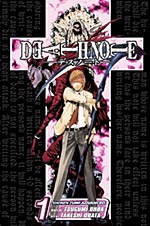 Written by Tsugumi Ohba
Written by Tsugumi Ohba
Art by Takeshi Obata
200 pages, black and white
Published by Viz
There are always series that you hear about, ones spoken with a sort of reverence. “Oh, you’ve got to read this,” is a familiar opening phrase. Sometimes you’ll even get the, “If you don’t like this, I’ll give you your money back,” gambit. After a while, it’s easy to get skeptical about such claims. Tastes don’t always intersect, after all, and even your most trusted friends can still lead you astray. In the case of Death Note, I was pleasantly surprised to discover that all of those praising it (before the series was even officially released) were wrong… because it was actually better than they’d claimed.
A Death Note is a notebook owned by a Shinigami, a god of death. The way it works is fairly simple: you write a person’s name in the book, and six minutes later they’ll die of a heart attack. If you want, you can get more creative: specify the exact time or type of death, for instance. Provided you’ve got the name of your victim and are thinking of their face, though, death is assured. High school student Light Yagami is a brilliant student, smart enough to do anything he wants for the rest of his life. Then Light finds a Death Note, and the entire world will forever be changed.
Tsugumi Ohba’s writing in Death Note is one of the real attractions of the series, because it’s almost like he’s deliberately meeting every demand of the reader. Death Note is one of the fastest-paced series I’ve ever read, hitting the ground running with idea after idea. In just a matter of pages the entire concept of the series is unveiled… and just a handful of pages later, Ohba’s already turning it on its head. Many people claim that manga is all full of “uncompressed” writing. Not only is the idea of categorizing an entire country’s creative output as being in a certain style ludicrous, but Death Note is a blatant rejoinder to that idea. At the end of each book, the series is at a radically different point than it began, all while staying true to the basic idea of the book. What other writers might drag out for 50 or 100 pages, Ohba dispatches in a way that is both quick and also immensely satisfying.
One of the best things about Ohba’s writing in Death Note is that this is one of the few series which stars two “brilliant” characters where as a reader I can actually believe this is the case. Both Light and “L” (the mastermind trying to stop Light’s killing spree) come across as ultra-intelligent people, each having their own unique strategies to try and stop the other. In many ways, it’s their dance around each other that makes Death Note so much fun; this isn’t a series where one side is hopelessly outmatched, but instead two people at the height of their powers who are each acting and reacting perfectly. In a medium so often dominated by the art, Ohba’s writing in Death Note is really impressive in every sense of the word. It’s genuinely one of the most surprising and exciting things being published right now.
That’s not to say, of course, that Takeshi Obata’s art isn’t good. It’s a great match for Ohba’s art, able to really bring the characters to life on the page. From Light’s smirk as he settles back into his chair while the rest of Japan goes crazy over the “Kira” killings, to L’s crazy-eyed look as he analyzes the situation, every character looks perfect. Obata has a great sense of body language, with characters able to convey their emotions through poses and movements. Even the rare action sequence, like a bus hijacking, works perfectly thanks to Obata’s art; from the desperate look on the hijacker’s face to the tense poses of the passengers, Obata absolutely delivers. It’s almost hard to believe that Obata is the same artist from Hikaru No Go, the two books are so different in tone and style. The one constant, of course, is that just like Hikaru No Go, Death Note is beautifully drawn.
In most books, when a supporting cast character that only shows up for a small portion of an installment suddenly dies, you just don’t care. Another FBI agent, another police officer… big deal, right? Death Note makes you wish that somehow characters can survive their fates, that the woman you just met that’s heading to her doom could somehow survive. That’s in many ways the ultimate complement for Death Note; you really care about everyone and everything in this series. Ohba and Obata have created my favorite new series in the form of Death Note, easily. This is one of the best books you’ll read all year. Highly recommended in every sense of the word, and with more books to come, your wallet may hate me, but the store owner should write me a thank you letter right now. You’ll be back for more, it’s just that good.
Purchase Links:
